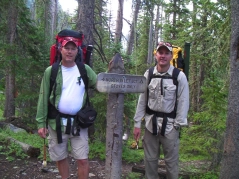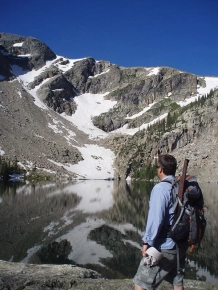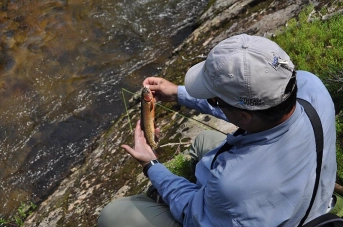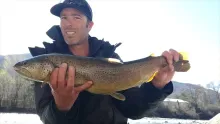Gaining 2,500 feet in altitude and hiking over 28 miles wasn't the tough part of this trip of a lifetime for first time GFF author Shane Murphy. It was resisting the temptation to fish every inch of the abundance of trout-filled water in the 4 days he spent in the Colorado backcountry. If you decide to fish the Colorado high country, Shane offers his description of the trip and shares tactics & flies you shouldn't forget
I have always understood that trout live in beautiful places. However, I never realized how beautiful some places can truly be. My entire life I have dreamed of the romantic rivers of the West and the mountains from where these rivers were born. I have longed to see snow covered ridges in July and hike through the lush green meadows sending a fly to the seams and runs of crystal clear trout streams. At the age of forty, I met my chance to see such places with wide eyes and a childlike exuberance. Rocky Mountain National Park had beckoned me and I was ready meander through the mountains of Colorado.
A trip to flyfish
the Rocky Mountains would fulfill a lifelong dream, but I was tentative and needed to know what I was getting myself into. Fortunately, I found Steve Schweitzer's A Guide to Fly Fishing Rocky Mountain National Park. The guide helped to relieve quite a bit of apprehension and helped me to prepare for both the fishing and the physical aspects of camping and hiking in the park.
I read religiously about what to take and what not to take. I began an exercise regimen to prepare my body for the hike at altitude with a thirty-five pound backpack. I read articles about what I would need and what would be nice to have. I searched internet websites and YouTube hoping to learn as much as I could, so that I could thoroughly enjoy every aspect of the park and the fishing I would encounter.
My trip to
Rocky Mountain National Park would begin with a drive through Estes Park and a quick stop at the park gates to pay the $20 per car fee for entering the park. The fee covers seven days including the day of arrival. From this point we traveled up Trail Ridge Road and through the park. The drive up Trail Ridge Road left me speechless. I was mesmerized by the mountains and the sheer scale of the park. My mind struggled to digest what my eyes were seeing. We crossed the mountains at 12,400 feet and were driving on the highest paved road in the U.S. Soon we were crossing the Continental Divide and were on our way to the west side of the park.
Over the mountain and to the woods we drove. The North Inlet Trail head is where we would start our journey by foot. This trail head is located on the west side of the park, just outside of the town Grand Lake. The trip started off easy enough, but as the pack grew heavier in that first mile the thought of six or seven more miles and the altitude we would gain, allowed doubt to creep into my head.
It is at this point
that I realized how important the advice I received about hydration was. The mountain air is very dry. There were three aspects that I learned before the trip that made this a much more pleasant experience. The first was hydration. Get your body hydrated before even leaving for the trip and continue to hydrate every thirty minutes of the hike. The second bit of helpful advice was to have lip balm handy. I prefer lip balm with sunscreen. The dry mountain air made quick work of my tender lips and I can only imagine how miserable I might have been without the balm. The last, but not the least important was ibuprofen. Altitude will cause swelling. Keeping any swelling at bay with ibuprofen eliminated the possibilities of severe headaches and other aches that might have occurred during our hike.
The hike
to the campsite was tiresome and tedious. Its most difficult aspect was the amount of water that we passed to get there. Every time we veered toward the water, my yearning to fish would make it difficult to move forward. Forward I flew, until we arrived at the campsite late in the afternoon. Backcountry campsites in the park must be reserved in person, by mail, or over the phone any time after March 1. The sites will fill up quickly so be prepared to make your reservation long before your intended trip. July and August are the busiest months so plan accordingly. Camping permits are $20 and must be obtained before starting your adventure in the park.
After a quick snack, we set up camp and were soon off to fish for the native Colorado River Cutthroats that inhabited the pocket waters around our camp. The fish were plentiful. Every good lie, seam, and pocket had an eager fish waiting to take my fly. The easy fishing and the eager trout were met with my childlike exuberance and soon the aching muscles and tired legs were forgotten and I was aglow with the smile of a child.
Fishing like this
normally occurs from mid July to mid September in the park. The fishing was easy. There were so many different bugs hatching, that any large attractor pattern seemed to work. The pocket water fishing that we were doing called for larger flies that were easy for both the fish and the fisherman to see. The two top fish producing flies for this trip were a grasshopper pattern and a Royal Wulff. However, fish were also caught regularly on parachute Adams and caddis patterns, as well as basic attractor nymphs and emerger patterns. The short growing season makes for fish that are not very picky and only eager for an easy meal.
After some wonderful pocket water fishing, we returned to camp to clean up and get a bite to eat before bed. I was surprised how many mosquitoes there were. I was thankful that bug dope was on my list of needs. There were many back pack lists that I read before packing. Some included necessities and others included niceties. Bug dope was a definite necessity. Among other things that I believe were imperative for this trip were a good sleeping bag and pad, a quality light weight tent and rain fly, a water filter, a lightweight stove for boiling water, and a rain jacket. A quick search of back pack lists on the internet will help you to prepare your pack according to your specific needs and wants.
After a quick clean up
, we prepared our dinners. Trail food is much like college cafeteria food: it isn't great, but it does the job. I would refer to it as nourishment. We quickly boiled water and poured it into the pouch of freeze dried food to soak for the prescribed period of time. Soon we were eating with sour faces and content stomachs. It was warm and it did the body good. Backcountry food can be purchased from almost any department chain store, sporting goods retailer, or specialized outfitter. I did not eat one meal that I thought was outstanding or may have been better than another. However, the breakfast skillet in a small tortilla did hit the spot on the second morning of the trip.
All food must be kept in bear vaults. This is a park policy. Vaults can be bought from a number of internet resources or even rented from various fly shops and outfitters in the area. We chose to rent ours. Anything that has an attractive odor must be kept in the vault. Lip balm, tooth paste, deodorant, soaps, food and food trash were all kept in the plastic bear proof containers and were moved to a safe and distant location every night.
Since fires are not permitted
in the park we found ourselves in bed early each night. The hard hikes and the maniacal mosquitoes forced us to our beds earlier than normal. A sleeping pad was a must on this trip. The older I get, the more a comfortable sleep means to me. Each evening of the trip our rest was interrupted by a visiting moose. It was mesmerizing to have such a large animal move in so close and yet be so quiet. The excitement of a very large bull delayed my rest a bit longer than it might have come otherwise.
Morning comes cool and early in the park. Watching the sun descend down the mountain where its warmth was met as a welcomed friend, made each morning a little more special. I am not a coffee drinker, but a cup of tea, instant coffee or even hot chocolate can bring much needed comfort to a very early morning. I would also encourage a person to pack a light down jacket and even a winter hat. Again, the older I get, the more important it is for me to be comfortable at all times.
Day two of our trip
would take us on an arduous hike up to 11,200 feet. On this day we would fish for cruising trout in a couple of the high country lakes that the North Inlet Trail system has to offer. The hike was slow and strenuous, but the beauty of the high country was something to behold. The solitude that you feel in such remote places is something of the spectacular. The fishing wasn't all that bad either. We fished two high country lakes through the afternoon and caught many cruising trout on ant patterns and small parachute adams. Again the fishing was secondary to the adventure of getting there and the beauty of the surroundings. My arms were often bruised from pinching myself. I was in a constant dreamlike state.
Mountain lakes can
call for a change of tackle and tactics. I fished the entire trip with a 7'9" 3weight rod and it did the trick. However, we did not encounter any weather or wind on our journey. I would recommend a second rod in the 4 to 5 weight range and at least 9 feet long for windy days on the water. There were plenty of fish and they were aggressive. However, a 7 to 9 foot leader with 5x fluorocarbon tippet helped to fool plenty of fish into sipping the fly. Fluorocarbon is not a must, but it does seem to come in handy in such clear waters.
Our day ended with smiling faces and a descent back to camp. For some reason the hike back seemed longer, but soon we were soaking our feet and filling our water bottles. I also took a very cold bath in the river. Biodegradable multipurpose soap was great for cleaning everything from my toes to my spork. A small towel was all that was needed. The dry air took care of the rest.
The third and final morning
of fishing would find us once again fishing pocket water. We rock hopped our way up the stream and caught many eager cutthroats. It was at this point that I wished I would have packed a small rag to dry my hands. I would also recommend a light-colored bandanna. This can be worn around the neck to help with the sun and dipped in the water to help keep you cool on harder hikes. It was at the end of this journey that we found ourselves in one of the most beautiful meadows I have ever seen. It was as if I were standing in a painting of some long ago artist. It was the background of every western fly fishing dream I had ever had. Here stealth and a good casts were much more important. The fish were easily spooked and demanded a good presentation. When things were done right, you were rewarded by watching your grasshopper being slowly sipped by a large unsuspecting cutthroat. I had lived my dream and I was thankful for it.
My final morning in this amazing park came with conflicting emotions. There was a large part of me that was thankful for the time and eager to once again speak with my wife and children. However, there was another part of me that was saddened to leave, knowing full well that I would probably never see this portion of the park again. The hike out was long, but visions of cheeseburgers danced in my head. I was eager to eat real food and tell my family of this amazing place. Rocky Mountain National Park is truly a treasure to behold.
If you plan on visiting the park, do your research and prepare your body. I would also encourage you to look into buying a good guide. I found Steve Schweitzer's A Fly Fishing Guide Rocky Mountain National Park to be the most helpful and comprehensive guide book that I have ever used. You can find it on Amazon or at his website. He covers every aspect of hiking and fishing in the park, as well as various resources to contact before or during your visit.
Preparation
I prepared for months for my trip to the mountains. I read every article I could get my hands on. I visited a multitude of websites from fly fishers to fly shops. I read through the Schweitzer's guide to flyfishing RMNP as if it were a class assignment. I was well prepared for the fishing. However, I needed to make sure that I was prepared physically and mentally for the hiking. Being from the Midwest, our altitude is fairly nonexistent. I wanted to make sure that I was in good physical condition before heading out on such arduous hike through the back country. I ran or biked daily to prepare my mind and body for whatever the mountains might throw at me. Hiking at elevations that ranged from 9500 to 11,200 feet would have been a tedious task had I not been as prepared as I was.
Facts
Gear: Rain jacket, tent, sleeping bag- temps in the 40's. A light down jacket and a winter cap for morning camp. Bear vault, extra socks- smart wool. Coffee or tea. a pillow. Mosquito spray. a good water filter. a light weight stove- no fires permitted on the park. Gorp. binos. A rag for fish slime and a bandanna for your neck.
Flies: standard attractors, parachute Adams, grasshoppers, Royal Wulff, Copper John, San Juan worms, ants, and caddis patterns.
When: Mid to late July through August
Where: North Inlet Trail head/ solitude lake, nanita, pettingell- not for the faint of heart. North Inlet creek.
Rods: Any quality click and pawl reel will work wonderfully. The cutthroats are not the most ferocious fighters. I used a 7'9" custom built three weight, but any 3-5 weight rod in the 7"6" to 9' foot range would work. On my trip I experienced very little wind, but a 9' 5 weight would have been a great rod for the lakes on a windy day
Avoid: doing anything stupid. Pace yourself. Make sure friends and family know where you are. Clean up after yourself. This place is a treasure. It was wonderful to be in places that made you forget about the destructive nature of man. It was also disturbing to be 9 miles back and find a clump of monofiliment line that was left ignorantly. If you pack it in, make sure you pack it out. I also made it a point to pick up that line and pack it out with me. Avoid getting close to the animals. A cow moose with a calf can be extremely dangerous during this time of year. Later in the fall, the bull moose and bull elk are much more aggressive as the prepare for the rut. Enjoy the animals, but be sure to keep your distance.
What to expect
We saw moose, elk, and a multitude of smaller animals. Expect majestic mountains, spectacular scenery, and easy fishing.
My hike
Around each corner, I found myself more enthralled with the landscape. I struggled to keep my camera in my pocket or the run for the river to send a fly into the pretty pocket water.
Fishing Rocky Mountain National Park in late July is somewhat easy, the fish are hungry and opportunistic. They were willing to feast on well presented flies and even a few that were not presented well. Patterns for the park were basic, big stimulators that were easily seen by both angler and trout. Small flies for the lakes, and a stealthy and careful approach to your quarry.
On most trips, the fish are the reward. Here the fishing is the reward. It was almost secondary to the trip itself. The park is an amazing place full of so many things to see that you become fearful that you just might miss something. The fish come easy, but the journey is both amazing and strenuous. This combination of feeling allows you to appreciate the fishing in the park far more than the catching. Yes, there are plenty of fish to be caught, but at the end of the day, you are more grateful for the journey than you are for the fish.
The morning ended a sleepless night
I was speechless as we made our way up Trail Ridge Road. Steve kept asking me if everything was okay. I was just trying to mentally digest the magnitude of these magnificent mountains. Every time I would comment on how awesome one view was, Steve would tell me to wait a minute and soon the views were even more spectacular. We stopped for a quick picture at 10,560, two miles above sea level. We were at the summit of the highest paved road in the U.S. We had to stop for a few more pictures before heading back down the other side of the mountain.
On the way down the mountain, we crossed the continental divide. We were soon looking at the headwaters of the mighty Colorado River. It was amazing to think that this was the same river that carved the Grand Canyon. We had to make a quick stop at the park office to change vehicle identification data and we were soon at the trail head. I am not sure how excited I was to carry a thirty-five pound back pack for seven and a half miles, but I was ready for my back country adventure to start.
Even after a long day, the scenery and the fishing seemed almost surreal. Steve was right, around every corner the mountains become more majestic and the scenery more spectacular. The smells and sounds were dream like. The wild flowers reminded me of my wife. The mushrooms reminded me of Matthew and his fascination for the colorful fungi. The rocks and mountains reminded me of Morgan and her love of stones. Even looking back now, I have to ask myself if wasn't just a dream. And it just kept getting better!
A childlike exuberance
The scale of things in Rocky Mountain National Park is something that you truly need to experience. Pictures and well meant words fail to describe the magnitude of the mountains and the surrounding forests. Everything there seemed to be more spectacular because of this setting.
If you are considering a trip to Rocky mountain national park, I would start by first buying Steve Schweitzer's book. I would then get my body physically fit and I would tie a handful of flies that you are confident with. You might also visit websites of some of the fly shops in the area. The Laughing Grizzly and Kirk's Fly Shop both…
- Log in to post comments




























Mr. Murphy!! It look
Mr. Murphy!! It looks like you had a great time,that wonderful! It seems like a nice place to go sight-seeing. The pictures really good!
-Kila
Great story and some
Great story and some wonderfull pictures, what a beautifull place to fish.
I think it is on everybody's hot-spot fishinglist.
best regards,
Tom Biesot.